I grew up in Ames, Iowa. The local Indian community in Ames has always been a big part of my life, and I imagine always will be. When I went to college in Iowa City I struggled to connect with other students of Indian origin, even though I participated in the Indian students’ association, I was in a group dance for Diwali one year, and I was even the master of ceremonies at the Diwali program the next year.
This struggle continued into graduate school, where I had a little more luck in making connections but still never quite found the right group. At Penn, there was the South Asia Society, which was heavily dominated by undergraduates. There was Rangoli, a student association primarily of PhD students in engineering and other sciences who grew up in India. The medical school, dental school, and business school all seemed to have their own Indian students’ associations. I ultimately became a member of the Wharton India Club, because they were a diverse, fun group of people who seemed most open to my participation. Nevertheless, I still felt like a bit of an anomaly, but also had a little more success connecting to the desi community in grad school than I did in college.
Now I live in Baltimore. I adore this city, yet its “black and white” mentality occasionally grates on my nerves. I have desi friends in this area (desi means of the country, as in “of India”) and yet still feel like an exception to the rule: desis are doctors or engineers and live in the suburbs while I am a city planner working at a community development nonprofit and I live in the city. I do not just live in the city to live close to work, I live here because I enjoy an urban lifestyle.
I have an Indian friend within the city limits who is a graduate student at Hopkins, and we bonded over both being anomalies – she’s studying public policy. We both really enjoy our dual culture, Indian and American.
Other than that, my other Indian friends live in Howard County or in Washington, D.C. I try to tell my Howard County friends that living in Baltimore is great, but they contest that there are hardly any desis here. The other night one of my friends told me that all the white young professionals he knew in his office chose to live in Baltimore city, whereas all the Indian young professionals chose to live in Howard County.
My D.C. friends seem to have an appreciation for Baltimore’s quirks but don’t have cars in which to come here. Furthermore, desis get why other desis would choose to live in D.C.: it's perceived as more diverse and with more fun things to do than Baltimore.
Feeling like an anomaly gets a little tiresome. Even though in many ways I think being different is one of my greatest assets, I still want to connect with the desi community. I want to be able to accept who I am while also accepting who they are. I often wonder if there is truth in our impressions of where we choose to live and work, or choose not to. A lot of times, people are pretty perceptive of their surroundings, but actually knowing some of the facts helps us know whether things are just in our heads or if there’s something to our impressions.
All of this is a long preamble to what may be the nerdiest thing I’ve ever done. In the same screwed up way that finally being diagnosed with a disease after feeling sick and not knowing why for a long time makes a person feel better, I thought I would look up some census data about where the desis are and see if I could diagnose whether I really am an anomaly. I looked at U.S. Census 2000 Demographic Profile Highlights for the Asian Indian Population for various geographies, based on Summary File 2 (SF 2) and Summary File 4 (SF 4). I also looked at U.S. Census 2000 Demographic Profile Highlights for the Asian population as a whole, based on Summary File 1 (SF 1) and Summary File 3 (SF 3) and U.S. Census 2005 American Community Survey Data Profile Highlights for the Asian population as a whole so I could get a sense of the changes from 2000-2005. Data for the Asian Indian subgroup of the Asian population is not available in the 2005 data, and not all places have 2005 data. All of this might sound complicated if you haven’t used Census data before – but it’s not as crazy as it sounds, look up http://factfinder.census.gov and you’ll probably be able to find some fun facts of your own.
People are always amused when I tell them I am from Iowa, because I do not exactly fit the stereotypical mental image of what an Iowan looks like. Plus people on the coasts or from large metropolitan areas find it fascinating that people, whatever their race, live anywhere in between. So two of the geographies I selected are my hometown Ames, Iowa and the state of Iowa as a whole. I also looked up Baltimore city, Baltimore County (which is not inclusive of Baltimore city), Howard County, and the state of Maryland as a whole, as well as the city of Philadelphia and Washington, D.C.
I computed the percentage of the total population in each selected geography that was Asian Indian and Asian, changes over time, and the percentage of Asians who were Indian. I compared percentages between the selected geographies. 
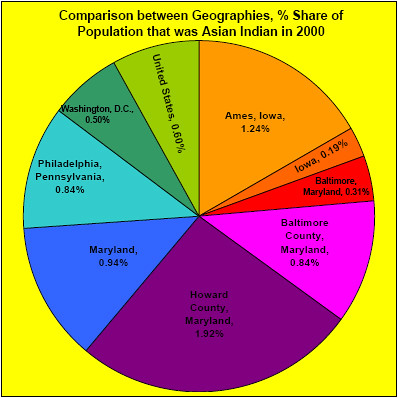
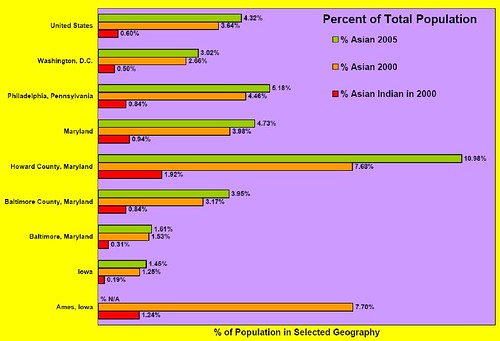
I also calculated the percentage of Indians who are foreign born – a lot of times, I think there is a societal bias towards thinking we are all immigrants, but I am American, born and raised. It is true that most Asian Indians are either immigrants themselves or come from families who have only been in the United States for one or two generations. Yet I feel strongly about asserting my identity as an Indian-American, and I think many of my counterparts do as well.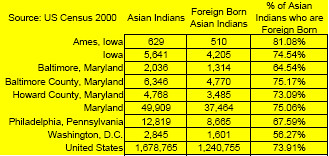
Finally, I calculated how many of us are homeowners, how many are renters, and how long, on average, most of us are willing to travel to work. I compared these numbers with numbers for the general population.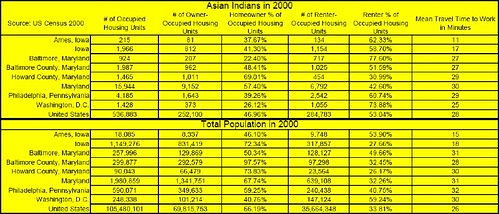
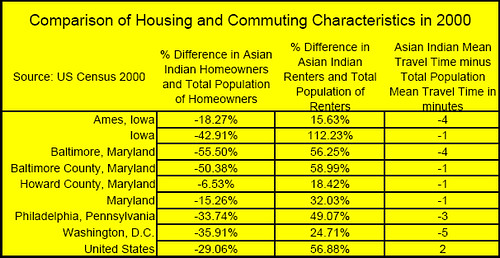
It seems that in all the selected geographies, Indians generally had a shorter commuting distance, but in the United States as a whole had a slightly longer commuting distance. I don’t know why it’s longer for the United States as a whole, I wonder if certain areas that I didn’t look at (such as the New York metro area or San Francisco Bay Area?) skew the results, or whether the areas I chose are unusual. But this confirms my sense that in the places where I’ve lived, Indians tend to prefer living close to work.
The housing data surprised me. Given that we are regarded as a relatively wealthy, upwardly mobile subpopulation, I thought we would exceed the average rates of homeownership. On the contrary, Asian Indians were less likely to be homeowners than the general population for every selected geography including the United States as a whole.
And regarding being an anomaly? Take a look at all the data for Baltimore city. Pretty abysmal I think... with the exception of the state of Iowa as a whole, Baltimore has the lowest percentage of Asian Indians in the places I analyzed. Anyone who knows me knows I would not advocate for Baltimore to lose any of its current population. I think this city could stand to add to its population, rather than replace anyone who’s already here. It would be nice if some more Asian Indians chose to live here, but they’re not going to just come-a-flocking just because I live here and I said it’s a great place to live. So, I am left wondering, what is it about our cities that fail to attract Asian Indians as residents, and why do the suburbs succeed in attracting Asian Indians? What in particular is it about Baltimore being the way it is, and Howard County being the way it is, what’s changing, and why?
Please feel free to comment on this post. I hope that people are able to see the charts and tables okay, right now they are jpgs but I might try to figure out how to get excel files in here directly or else work on hosting my own website. For the moment I think I've exceeded my nerdiness quotient, at least for the day.
If there are particular things you’d like to add or you’d like me to look up let me know, this is just a start. I know there are many cities and many subpopulations I didn’t look at, and that this analysis is very basic... but I hope it gets a dialogue going!


